Process Steam
Process steam is a versatile manufacturing tool for heating certain types of manufacturing equipment, in-process goods, and for indirect heating of cooking equipment like jacketed kettles.
It can also be used to clean and sterilize equipment. Electro-Steam’s comprehensive line of all electric-fired miniature boiler steam generators can meet your needs for point-of-need process steam.
What Is Process Steam?
Manufacturers often use heat for different aspects of their production processes. Some examples of how process heat is used include melting, drying, cooking, curing, and pasteurizing. The heat can be generated by various means, including combustion of fuel, electricity, or steam to clean steam exchangers.
Process steam is often used in lower-temperature manufacturing processes that take place under 212°F. Steam can be applied directly, such as spraying it at or on an item or injecting steam into water, or indirectly by heating or powering equipment used in the process.
How Does Steam-Based Process Heating Work?
Process steam systems hold volumes of steam at a constant temperature and distribute it to multiple equipment stations and points of use through a piping system. Once steam is generated, it can be used in several ways:
- Introducing low volumes of steam into a controlled or closed environment to provide a consistent, low level of heat.
- Indirectly transferring heat to items by filling a closed container, such as a tank, kettle, radiant heating tube, or roller, with steam. The heat is transferred through the container wall to the items.
- Directly transferring heat by injecting steam into water or cooking liquid to heat it, or into or onto the materials themselves.
Applications and Benefits of Process Steam
According to 2018 Manufacturing Energy and Consumption Survey (2018 MECS) data, steam makes up approximately 30% of all US manufacturing process heat. It is used in several industries and applications in which process heat requirements are below 400° F including drying, curing, melting, pasteurization, cooking, sterilizing, and cleaning.
Point-of-use process steam equipment is found in a wide range of industrial and commercial facilities, including factories, hospitals, laboratories, and more.
In the manufacturing sector, specialized systems employ the use of process steam as a cost-effective source of energy. Compared to other energy sources, it offers numerous advantages, including:
- Easier Transportation: Given access to a supply of water, steam is easy and economical to generate as needed. It is also much simpler to supply to the necessary processing systems. Small and Portable electric fired steam generators make it easy to have point-of-use steam, on demand when and where it is needed.
- Lower Toxicity Levels: Unlike other fuel sources, steam produced electrically- from clean water sources does not contain chemicals that are likely to cause adverse health effects.
- Higher Heat Production Efficiency and Capacity: Process steam is highly efficient at delivering and distributing heat within a system. Additionally, a small amount of steam can carry a significant amount of energy.
- Lower Production Costs: Process steam systems are relatively inexpensive, readily available, and easily maintained. Additionally, they cost less to operate than other systems, especially fuel-fired boilers.
Saturated Steam vs. Superheated Steam
Two primary types of process steam are saturated steam and superheated steam. Saturated steam is generated in a closed container and vaporized to remove moisture. It is considered dry steam; although, in practice it contains 3-5% moisture. With a high heat transfer coefficient, saturated heat provides quick and even heating, and temperatures are easily controlled by adjusting pressure. It is the most common choice for providing heat and energy in industrial applications.
Superheated steam is created by heating saturated steam beyond its boiling point to separate vapor from any remaining water in the steam. It can exist at a variety of temperatures because it has a lower density than saturated steam. A secondary heating chamber is used to turn saturated steam into superheated steam. It is a less common choice for providing heat or energy, and instead is primarily used for cleaning and sanitizing in food operations, as well as sterilizing medical and other equipment.
Electric Steam Generators for Process Steam
For companies looking for quality electric steam generators, Electro-Steam is the ideal partner.
At Electro-Steam Generator Corp, we have designed and manufactured superior electric-fired miniature boilers for over six decades. In addition to having a compact design, they require no venting, use no combustible fuel, can accommodate a wide variety of pressure requirements and flow rates, as well as facilitate direct hook-up to process equipment without the need for long steam lines and expensive piping. The steam generators we offer include:
- LB-series electric steam generators (40, 40–60, 80, and 100–240 kW)
- Stainless steel LB-series electrical steam generators (40, 40–60, 80, and 100–240 kW)
- LG-series electric steam generators (10, 15, 20, 25, 30 and 40 kW)
- Stainless steel LG-series electrical steam generators (10–40 kW)
- SV-series electric steam generators (3.3, 5, 6.6, 8.3, and 10 kW)
- VB-series electric steam generators (10, 15, 20, 25, 30 and 40 kW)
Contact the Steam Experts at Electro-Steam Today
Process steam plays a critical role in many industrial and commercial operations. As an experienced and knowledgeable steam generator manufacturer and distributor, Electro-Steam offers a broad selection of products that can meet any customer need. For additional information about our product offerings or assistance choosing a steam generator for your facility, contact us today.
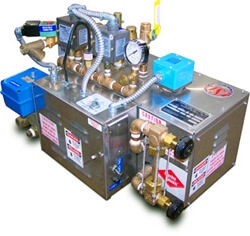
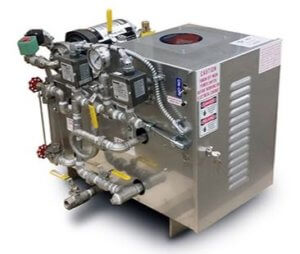
| Models | |||
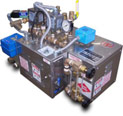
|
SV-Series | 3.3, 5, 6.6, 8.3 or 10 kw | 0-100 Psi |
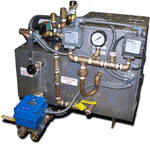
|
LG-Series | 10, 15, 20, 25, 30, or 40 kw | 0-100 Psi |
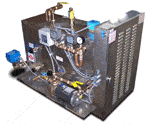
|
LB-Series | 40, 50, 60, 80, 100, 120, 150, 180 or 240 kw | 0-100 Psi |
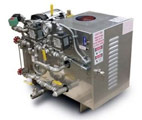
|
Stainless Steel LG-Series | 10, 15, 20, 25, 30 or 40 kW | 0-100 Psi |
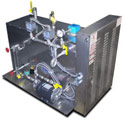
|
Stainless Steel LB-Series | 40, 50, 60 80, 100, 120, 150, 180, or 240 kW | 0-100 Psi |
 Proudly Manufactured in the USA
Proudly Manufactured in the USA 